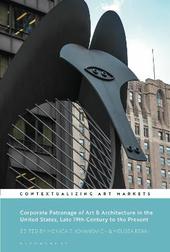
|
Corporate Patronage of Art and Architecture in the United States, Late 19th Century to the Present
Hardback
Main Details
Description
This interdisciplinary collection of case studies rethinks corporate patronage in the United States and reveals the central role corporations have played in shaping American culture. This volume offers new methodologies and models for the subject of corporate patronage, and contains an extensive bibliography on corporate patronage, art collections and exhibitions, sponsorship, and philanthropy in the United States. The case studies herein go beyond the usual focus on corporate sponsorship and collecting to explore the complex organizational networks and motivations behind corporate commissions. Featuring chapters on Margaret Bourke-White, Julie Mehretu, Maxfield Parrish, Pablo Picasso, Diego Rivera, Eugene Savage, Millard Sheets, and Kehinde Wiley, as well as studies on Andrew Carnegie, Andrew Mellon, John D. Rockefeller Sr. and Jr., and Dorothy Shaver, and companies such as Herman Miller and Lord and Taylor, this volume looks at a wide array of works, ranging from sculpture, photography, mosaics, and murals to advertisements, department store displays, sportswear, medical schools, and public libraries.
Author Biography
Monica E. Jovanovich is Assistant Professor of Art History, Golden West College, USA. Melissa Renn is Collections Manager, HBS Art and Artifacts Collection, Harvard Business School, USA.
ReviewsMore than just a necessary corrective to the prevailing scholarly inattention to the private sector's consumption of the visual arts, Corporate Patronage of Art & Architecture in the United States demonstrates how extensively the histories of art and commerce interlace. Brimming with archival gems, fresh interpretations, and new interpretive frameworks, this collection of essays by fourteen authors examines artistic commissions of remarkable variety and complexity, both in terms of their underlying motives and their outward manifestations: hospital architecture, installations for office buildings, banks, and ocean liners, department store displays, furniture design, magazine advertisements, contemporary sportswear, and even the very materials from which art is made. Often circulating beyond the white cube of the museum, these collaborations between cultural producers and business enterprise, moreover, represented most Americans' first or primary exposure to modern art, design, and architecture. This volume will not only encourage business historians to take corporate visual culture more seriously but also urge art historians to reconsider the facile distinctions between commercial culture and the avant-garde that have shaped the field. * John Ott, Professor of Art History, James Madison University, USA * Writing in 1927, the American advertising executive Earnest Elmo Calkins declared that "beauty [is] the new business tool." This anthology re-considers the modern alliance between art and industry that laid the foundation for the ubiquitous corporate sponsorship of our own time. Calkins would have approved, thankful for this new history of beauty and business. * Regina Lee Blaszczyk, Leadership Chair in the History of Business and Society, University of Leeds, UK *
|